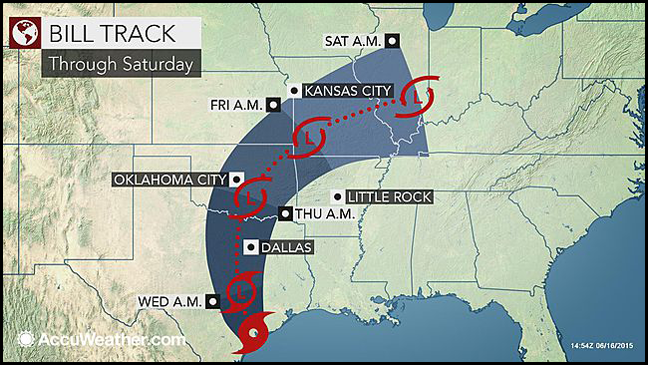TS Bill, Heatwaves Keep Upward Pressure on Natural Gas Prices
Tropical Storm Bill and heatwave concerns continued to apply upward price pressure to natural gas physical prices on Tuesday, as NGI‘s National Spot Gas Average increased a nickel to $2.69. However, the gains were a bit more subdued than on Monday, as most individual price points across the country added between a couple of pennies to a dime.

Meanwhile, over in the natural gas futures arena, it appeared traders were taking their feet off of the gas pedal and assessing a situation that saw the July contract jump nearly 14 cents on Monday (see Daily GPI, June 15a). In Tuesday action, the prompt-month contract traded in the red nearly the entire session and reached a low of $2.831 before closing out the day at $2.894, up half a penny from Monday’s finish.
Down in the Gulf region, gains stayed well inline with other parts of the country, despite the inclement weather. The Henry Hub for Wednesday delivery added 7 cents to average $2.93, while the Houston Ship Channel tacked on 3 cents to $2.83.
Sweltering temperatures out west also continued to keep upward price pressure on key points. PG&E Citygate added 3 cents to average $3.18, and Socal Border increased by 6 cents to $2.93.
The Frontier Weather six- to 10-day outlook for June 21-25 is calling for above average temperatures for much of the continental United States, with “normal readings” in the northern Plains and in Texas as the exceptions. Looking a bit further out, the forecasting firm in its 11-to 15-day forecast covering June 26-30 said temperatures are seen averaging warmer than normal in the West and most of the East, with normal temperatures for this time of year expected in the central United States and near the Great Lakes.
Even as oil and gas producers were battening down the hatches and removing nonessential personnel in the Gulf of Mexico ahead of Tropical Storm Bill (see Daily GPI, June 15b), forecasters continued to predict that onshore areas were likely to be in more trouble than offshore, thanks to driving rain, high winds and flooding. A polling of Texas producers Tuesday by NGI revealed no shut-ins or work stoppages due to the storm.
“Rainfall will result in significant flooding across central and eastern Texas through Wednesday, including the cities of Houston, Dallas and Austin,” AccuWeather Meteorologist Chyna Glenn said.
The heaviest rain, and hence the greatest risk of flooding, on Tuesday into Thursday will be focused on the upper Texas coast, central and northeastern Texas and central and eastern Oklahoma, Glenn added, noting that many of these locations may receive double-digit rainfall this week, which would be on top of one to two feet of rain that hit during May.
Genscape Inc.’s Rick Margolin noted Tuesday that Lower 48 dry gas production is lagging due to storms, flooding and maintenance, with more on the way. He added that Genscape subsidiary Spring Rock has a daily pipe estimate that shows Lower 48 dry gas production is continuing to lag recent rates due to storms in the Gulf of Mexico, flooding in Texas and the Midcontinent, and maintenance.
“Production is estimated to stand just above 72.7 Bcf/d, nearly 0.5 Bcf/d below the May average, and more than 1 Bcf/d lower than the 30-day high of 73.7 Bcf/d set on May 23,” Margolin said in Genscape’s Tuesday Natural Gas Basis report. “The bulk of the declines are in Texas (down 0.29 Bcf/d vs. 30-day average) and Gulf Coast (down 0.23 Bcf/d vs. 30 day). Production in northeast Pennsylvania is down nearly 0.33 Bcf/d due primarily to maintenance around Leidy.”
However, of note is the fact that total East region production is down just 0.13 Bcf/d as growth in the Ohio Utica is helping offset the northeastern PA declines, he added.
Tim Evans, an analyst with Citi Futures, acknowledged that the Texas storm could certainly impact Gulf of Mexico production, but warned that market watchers can’t ignore the other side of the equation.
“The natural gas market has trimmed its recent advance as the impact of Tropical Storm Bill now seems as likely to hurt onshore demand as to curtail production from the Gulf of Mexico,” Evans said Tuesday. Tuesday’s “temperature outlook is also somewhat less supportive than a day ago. Estimates for Thursday’s DOE [Department of Energy] storage report are running in the vicinity of 95 Bcf so far, a bit below our model’s 101 Bcf estimate, but still somewhat more than the 86 Bcf five-year average for the week ended June 12.”
© 2024 Natural Gas Intelligence. All rights reserved.
ISSN © 1532-1231 | ISSN © 2577-9877 |
